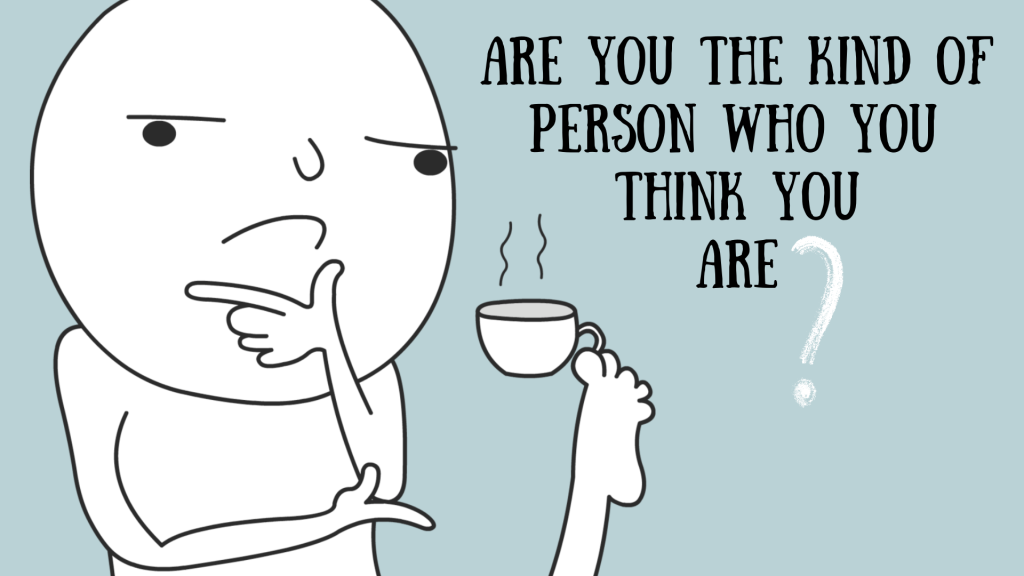
Who are you really? Ever wondered about something so trivial yet so powerful? Most of us would be having an image of our own self in our brain but is that really who we are? Is that how society perceives us to be? So many baffling questions tend to arise when we ponder on who we are, as a person.
However confused or self-aware you tend to be, you will kind of have a vague idea about yourself. It is because nobody else would be knowing you better than your own self! And, that is called our self-image, which is part of our self-concept. But, how does one come to a conclusion or notion as to who he/she is or isn’t? I mean, as human beings, we don’t come with an instruction manual and a brief description of our personality! (If so, that would have made life less difficult!).

When we are born into this world as a baby and open our tiny eyes and try to fit into a new world outside of our mommies’ comfy womb, we have no idea as to who we are and what we will become out of this life. We are all born clueless; it’s just that as babies, we don’t generally have the thinking capacity to retrospect about life and formulate a sense of self!
So, how does this process of development of one’s self-image take place? Honestly, it takes place right from our childhood, our early development as a baby human. There are so many interesting theories as to how we eventually develop our self-image and self-concept. Let’s read on to understand what exactly is meant by self-concept to further know more about self-image.

What Is Self-Concept?
Self-concept is our knowledge or understanding of who we are, as a person. We would all be having certain distinguishable factors from others and areas in which we tend to stand out more. For example, person A would have a self-concept that he is a creative person, person B would think of herself as an empath, person C would consider herself to be a good listener. All of these insights or awareness’s about one’s personality and characteristics are part of having a self-concept.
In general, self-concept is how you perceive your unique behaviors, abilities, and characteristics to be and formulate a conclusion or a brief understanding about your personality from it. It is how you describe yourself as a person. Everybody’s self-concept would be unique as we are all unique in one way or the other.

Carl Rogers, a very famous American Psychologist who is the founder of the humanistic approach in Psychology formulated three different components of the self-concept of a person. They are as follows:
- What a person thinks of himself (self-image) or how he/she views himself/herself.
- How much value a person gives to himself/herself (self-esteem or self-worth).
- What a person aspires to be or wishes they really were (Ideal self).
The concept of the ideal self which was popularized by Abraham Maslow in his need hierarchy theory of motivation has already been mentioned in one of my articles where I discussed the signs of a mentally healthy person. Self-actualization, wherein one aspires to climb the top of the mountain to attain his/her ideal self is one sign of a mentally healthy person!
Another great, famous British social psychologist, John Turner, along with his colleagues propounded the self-categorization theory. This theory points out that our self-concept includes at least two levels, which are:
- The personal identity and,
- The social identity.
In other words, self-concept depends on how you perceive yourself and how others perceive you. Self-concept can quickly alternate between personal identity and social identity.
Somewhere along with the same concept is another well-known theory of self-concept introduced by a social psychologist, Michael Lewis. He also proposed the theory that there are two key components to the development of personal self-concept, and they are as follows:
- The existential self: It refers to the self-awareness and realization that you exist separately from others.
- The categorical self: It is the absolute self-realization that you exist in the world as an individual with different attributes, such as your age, hair color, and gender. As we age, this component also begins to include our psychological characteristics.
In conclusion, a person’s self-concept (also called self-construction, self-identification, and self-perception or self-structure) is a collection of beliefs about oneself. Though the terms self-concept and self-image are often used interchangeably, I would say that self-image is just a part of our self-concept because self-concept is an embodiment of who we are, and it constitutes various other aspects of our self. Let’s read on further to find out what self-image is and how does one develop a sense of self.

What Is Self-Image?
A major part of self-concept is our self-image. Self-image basically refers to what kind of a reflection we have about our self. It is a mental image, usually a type that is very resistant to change. It not only represents the details (height, weight, hair color, etc.) that other people may conduct objective investigations on but also represents whatever you have learned about yourself, that is, your own perception of yourself, whether it comes from personal experience or internalizing the judgement of others.
Let’s check out some interesting theories related to the development of a person’s self-image!
The Development Of Our Self-Image – Interesting Theories

The Looking Glass Self
According to this theory developed by Charles Cooley, we develop the concept of ‘self’ through a gradual and complicated process that continues throughout our life. This concept is an image that one builds only with the help of others. For example, ‘‘I am skinny/chubby’’, ‘‘I am a tall/short person’’ etc.
Whether one is intelligent, average, attractive, homely, virtuous, or sinful; all these and many other ideas of the self are learned from the reactions of our associates. When I first learned about this theory in one of my sociology classes, I got confused reading this quote by Cooley-

Once I understood the meaning, I started liking this theory more. Any person who is into the act of soul searching often and is always on a journey of self-discovery or self-exploration can surely benefit from this theory!
The ‘Looking Glass Self’ theory makes us understand that the elementary knowledge of our self comes only when we compare ourselves with others. There are three major steps in the process of building the looking glass self. They are as follows:
- Our imagination of how we look to others.
- Our imagination of their judgement of how we look.
- Our feelings about these judgements.

Take a look at the image above to know how the ‘looking glass self’ theory helps us in formulating our self-image, which is part of our self-concept.
What do you see when you take a look at yourself in the mirror? A reflection of your physical self, of course! Just like that, the perception of the reactions of others gives an image of the ‘social self’. For example, others may label you as a ‘talented person’, ‘wonderful orator’, ‘handsome man’ etc.
From this theory, we can learn that knowledge of our ‘self’ leads to the development of self-knowledge. This theory also says that self-knowledge is first gained from our parents and is further modified by us based on the reactions we receive from other individuals, later in our life.
Significance Of Our Childhood Experiences – Looking Glass Self Theory
As I reach this part, I can’t help but emphasize the importance of our early childhood experiences that would definitely have a huge impact on our adult life as well. This is why childhood is a significant part of our life and it is the foundation period where the ultimate, primary, development of our ‘self’ initiates. If the child receives harsh criticisms and negative reinforcements from time to time, the child is bound to think of himself/herself to be an ‘inferior’ and that would lead to the development of low self-esteem and can also result in having inner child wounds which would manifest into our adulthood, no matter how much we run away from it. And, it is difficult to completely change a negative impression formed in early childhood. If a child has low self-esteem, it can lead the child to develop an unhealthy sense of self that isn’t favorable to the child nor the society in which the child resides.
The functioning of the looking glass self develops from early childhood as we mentioned and it is more influenced by anyone who is intimate to us, be it our parents, siblings, grandparents, uncles, aunts, etc. However, the functioning of the looking glass self, in our later life is influenced by the discrimination that we face from others.
The Looking Glass Self – Important Facts
- Basically, as we mature, we develop something called ‘reference groups’ to which we give special attention. We imitate them and try to be like them.
- If we take a look at our life, we can know that we pay more attention to some reactions of others or we may misjudge the reactions of others. But, it is from all these, that we subconsciously develop our self-image.
- So, based on the ‘looking glass self’ theory, the ‘self-image’ which the individual perceives about himself/herself may differ from the image others have actually formed out of his/her personality.
- In general, studies have indicated that most people perceive fairly accurately the judgements of others about them.
- Thus, it is our perception of the responses of others in our lives and not their actual responses which shape our self-image!
This theory could be pretty confusing at first but I most definitely think that it does teach us a lot about our self-image, and through this, we can also get a chance to reflect upon our childhood to better understand how the development of our self-image actually began!
Alright, time to move on to the next theory!
Mead And The Generalized Other
The process of internalizing the attitudes of others has been described as the ‘generalized others’ by George Herbert Mead, who is an American philosopher and a well-known social theorist. This theory states that the ‘self’ becomes reflective by internalizing the attitudes and behaviors of others with whom we are associated, in our lives.
Here, we look at our self as though we were another person and judge our actions accordingly. A perfect example of this is the development of play-related activities of children. I will give you an easy example of this so that you can understand how the development of our ‘self’ evolves with regard to this theory.

Take the example of a girl child playing with her favorite doll. Generally, they have a way of playing the role of their dad or mom and pretend that the doll is their ‘child’ and treat it just like how the girl’s actual caregivers or parents treat the child! You can often see kids using the exact same remarks as their parents while talking and playing with their favorite toys. So, from where do you think that they learned those dialogues? It is because of the early and vital socialization process that they engage in, with their parents or caregivers. This means that the child immediately picks up everything that you say to them and a part of their play-related activity would often seem to depict similar traits in them as well. The child, therefore, learns attitudes and behaviors from their parents and other primary caregivers and internalizes it and this internalization gives rise to the concept of the ‘generalized others’.
If I have to simplify this theory further, all this means is that by viewing situations, events, people, and objects from an anonymous perspective, that is, from the viewpoint of some other person in our life, the child would eventually be capable of visualizing and processing the general expectations of others in the society and view himself/herself from the point of view of groups of others (be it their parents, relatives, friends, society or community, etc.), and this viewpoint is called as the ‘generalized other’.

This developing awareness about the social expectations of others is a vital part of our self-development. And, according to this theory, this is one way in which we develop our sense of self and our self-image.
Learning about such theories might make the deep introspection into your self-image difficult in the beginning, but it would certainly help you in gaining more knowledge related to such interesting theories about how one develops a sense of ‘self’.
This theory of George Mead is often closely associated with another universally famous theory of Sigmund Freud, which is my personal favorite as well. Let’s go read that!
Freud And The Anti-Social Self
Sigmund Freud, who is popularly acknowledged as the father of modern Psychology propounded the Psychoanalytic theory. According to the Psychoanalytic theory by Freud, all of us constitute three components in our unconscious mind, namely the Id, Ego, and Superego.
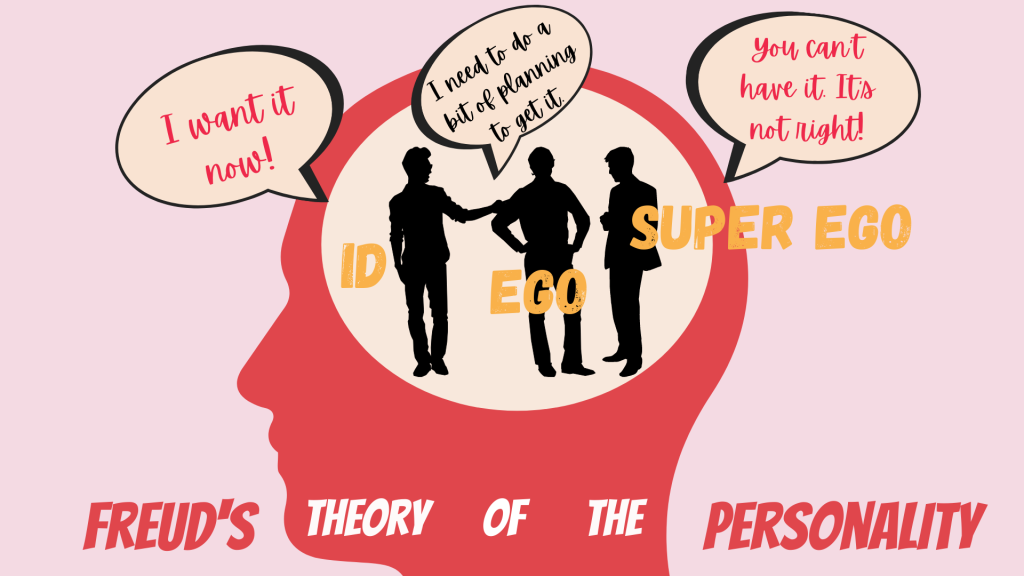
The Id is the primitive and instinctual part of our mind which desires instant gratification and is propelled by deep sexual and aggressive drives or desires (which is the crux of the primary motives of mankind as far as this theory is concerned!) and repressed or hidden memories of the past.
The superego constitutes all of our morals, values, and principles that we uphold in our life, mostly act like the moral compass that regulates us from committing sins and engaging in doing bad deeds as this part of our mind helps us in differentiating between what is right and what is wrong. Even our religious values come under our super-ego. The superego is our morality principle.
The word ego is not unfamiliar to us as we usually use it to describe a part of our human psyche and behavior. But, the ego doesn’t function alone and Id and super-ego are what make the ego function. The ego, which is the reality principle acts as a mediator between the desires of Id and the superego.
If you are still confused, consider the Id as the devil and the super-ego as the angel and the ego as our actions! Take a look at the image down below to get further clarity.

So, how is this famous psychological concept related to the development of our self-image? Read on further to find out how it is all linked!
According to Cooley who came up with the ‘Looking Glass Self’ theory as mentioned in the former part of my article, the self and the society are interdependent and the society has no existence without the individual, that is, us. However, this concept was challenged by Freud with his famous psychoanalytic theory wherein he saw no identity of the self and society. Freud believed that the rational portion of human conduct was like the visible tip of an ice-berg with the larger part of human motivations remaining unseen or hidden in the unconscious part of our mind, which powers and fuels most human conduct in reality. Take a look at the illustration down below to understand more.

So, coming back to the question as to how this is linked to the development of our self-image; Freud, based on his Psychoanalytic theory, divided or classified the self into three parts (as mentioned above):
- The Id – This represents our instinctive desires, which may be viewed as an un-socialized aspect of our nature human.
- The ego – This makes us act upon our desires.
- The superego – This is basically our inner conscience. It represents the social ideals and values that we have internalized.
So, basically, all of us have these three different parts of our self and if we have a distorted sense of self, it would be because we have a lack of awareness of our inner conscious mind, as far as this theory is concerned. If you are unable to distinguish between what is right and what is wrong and end up acting upon your deep, inner desires which aren’t socially acceptable, that might make you end up in a lot of unwanted trouble. Therefore, understating and listening to our Id and superego and making use of our ego in the right way is the key to success in our life.
However, one can argue that what may be right for someone may be wrong for the other. This is why I specified about the ‘socially accepted’ part. For example, murdering someone (other than in the case of certain exceptions like for self-defense) is a cruel, unjust, and evil act. But, for some people, murdering people wouldn’t be a ‘bad’ activity as they are, indeed, ruthless and apathetic. This is when you have a negative self-image and that is what we need to stray away from.

If we hate one of our teachers so badly, our subconscious mind (the id) may force us to kill or do something that causes some kind of harm to that teacher! I remember when I was in 4th grade, we were supposed to have a math test and the whole class was unprepared (including me) and all of us prayed for the teacher to fall sick, haha!!
So, similarly, there may be students who would ‘feel’ like killing the teacher, but if they have an inner conscience, their superego would make them feel bad for having such thoughts and prohibit them from doing anything like that. However, there can be students who would attempt to actually cause harm or murder the teacher (this is when they let their ‘Id’ take full control over their mind and their ego would give in and act upon it). Such behaviors are linked to psychopathy and sociopathy.
So, my point is, if you read more about psychological theories, you can refine your character and develop more self-awareness! So far, we have discussed about self-image, but what about our body image that stems from it?
The Link Between Our Self-Image And Body-Image

What Is Body Image?
The concept of body image is used in many disciplines, including Psychology, Medicine, Psychiatry, Psychoanalysis, Philosophy, culture, and feminist research, etc.; the media also often utilizes this term, many a time. Anyhow, in these disciplines, there is no single consensus definition, but broadly speaking, body image refers to the way in which people view themselves, that is their physical self, and attribute a mental image to it.
Based on our perceptions about our physical self, we can develop a healthy or an unhealthy body image. The same goes for our self-image. Sometimes, even though, we may have a positive sense of self, we may tend to subconsciously develop a negative body image and that is especially propelled by the prevalence of unattainable beauty and body standards that the media popularizes.
This is why it is important for us to have a positive sense of self because if we have a healthy self-image, we would not be prey to such ridiculous standards set up by society as we would be having something called ‘self-worth’ and that wouldn’t ever change, once your subconscious mind attains it. A positive body image contributes to better psychological adjustment (we would be less prone to depression, develop positive self-esteem, attain life satisfaction, develop less interpersonal anxiety, fewer eating disorders and it would help us from falling prey to body dysmorphia).

Factors Influencing Our Body Image
Our body image, be it healthy or unhealthy is influenced by several individual and environmental factors. They are as follows:
- How you physically see/view/perceive your body is your perceived body image. This is not always the correct representation of who you really are. For example, a person may think that he is overweight when in fact he is underweight.
- How you feel about your body is your emotional body image. This is related to how satisfied or dissatisfied you are with your body shape, weight, and individual body parts.
- Your perception of your body or the way you mentally think about your body is called your cognitive body image. This may cause people to worry about body shape and weight.
- The behaviors in which you indulge in because of your body image include your behavioral body image. When a person is dissatisfied with their appearance, they can isolate themselves because they feel terrible about their appearance.
This is why having a positive self-image is cardinal. Let’s read on further to understand the two different types of self-image and how early childhood experiences help us in shaping a positive self-image.
Types Of Self-Image
There are two main types of self-image that we may tend to have. They are as follows:
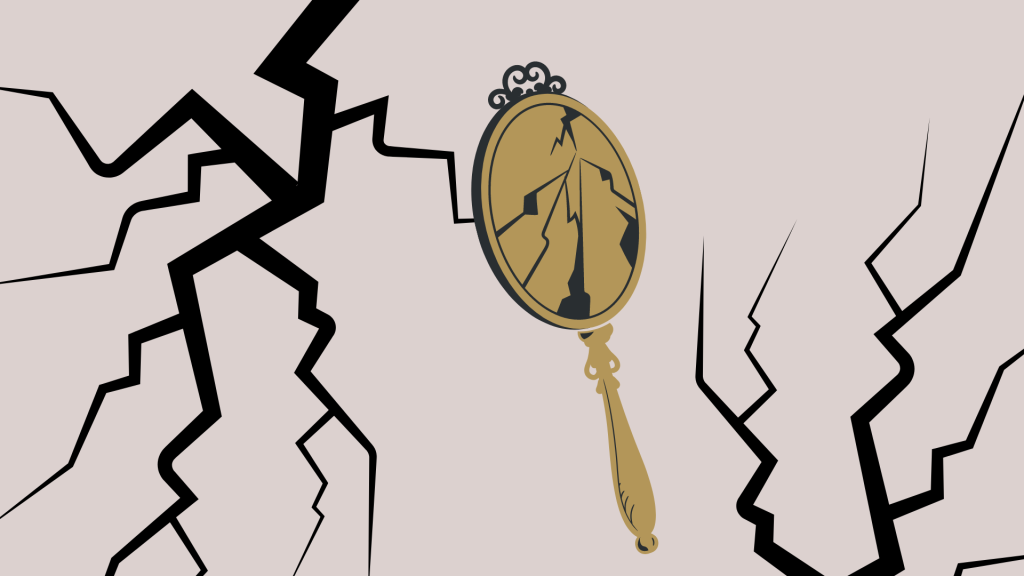
Unhealthy/Negative/Poor Self-Image
A negative self-image leads to the generation of a negative self-concept in you. With a negative self-image, we focus on our flaws and weaknesses, and imperfections. Certain times, people who are perfectionists and tend to be overachievers may also subconsciously have a negative or unhealthy self-image. Though most of it has to do with our early childhood experiences, throughout learning psychology, I have learned that people who set up unrealistic standards for themselves and ultimately fail due to these unattainable standards, end up having deep, self-image issues. So, if you are anything like that, try to understand that and move and succeed in life through practical goal setting!
Problems That May Arise Due To A Negative Self-Image
Here are some serious problems that tend to arise in life if you have a negative sense of self:
Personality Disorders
We’ve talked about an unhealthy self-image, but what if we don’t even have a self-image or a self-concept. It could be difficult to believe but there are many who struggle with understanding who they are. And, I am not talking about the identity crisis we have during our teenage. People, even in their 50s might be finding it very difficult to form a mental identity of themselves.
A distorted or a lack of sense of self is not exactly the sign of a mentally healthy person and it can be attributed to being a sign of Borderline Personality Disorder. It is a pretty common personality disorder; In fact, it is too common these days (according to relevant statistics and research works) that it is not even considered as a ‘disorder’. It definitely is one, though. But, that doesn’t mean that you can’t develop a positive sense of self. You most definitely can!
Other Mental Health Issues
Having a negative self-image can lead to the generation of other mental health issues or can contribute to poor mental health.
Body Image Issues
As mentioned above, you will be more prone to developing eating disorders, body dysmorphia, and the like. Approximately 91% of women are unhappy with their bodies and resort to dieting to achieve their ideal body shape. Unfortunately, only 5% of women naturally possess the body type often portrayed by Americans in the media. 58% of college-aged girls feel pressured to be a certain weight. 95% of people with eating disorders are between the ages of 12 and 25. So, what does this say about their self and body images?
Self-Esteem Issues
The root cause of poor mental can be attributed to having low self-esteem. It can also lead you to comparing yourself with others and following a negative thought pattern, religiously. Having a strong self-image can, to an extent, help you in developing good self-esteem.
Affects Overall Wellbeing
Ultimately, all of this together would negatively contribute to your mental, physical, emotional, and spiritual well-being. A negative self-concept and image can take a toll on your overall well-being. This is why it is encouraged to possess a healthy view of your own self. If you are not happy with yourself, how can you be happy with the world?

Healthy/Positive/Rich Self-Image
A person with a positive self-image would be able to recognize and own their skills and potential while remaining practical and realistic about their weaknesses, responsibilities, limitations, and shortcomings, and it is with a healthy self-image that they would be able to embark on a journey of self-development and self-discovery to work on themselves and to improve themselves.
A positive self-image is the first step to developing our self-awareness. And, we all know that being self-aware or having sufficient knowledge about ourselves is the biggest asset that we can boast of, proudly. Self-awareness does not take place one night and it’s a journey and an ongoing process as well as a sign of a mentally healthy person.
Since you’ve come this far, let me ask you, do you have a positive or a negative self-image? Well, let’s find out that through a mini self-image test!
Self-Image Test

The test below is just supposed to give you an idea as to whether you have a positive sense of self or not. It doesn’t matter even if you have a negative sense of self as there is still time for us to improve our self-image. Taking this test might be your first step to that journey! Read on further to gain more knowledge about developing a healthy self-image and self-concept. Download the PDF file here.

The Relationship Between Our Self-Image and Self-Esteem
Let’s talk about the most important asset we should possess in life – good self-esteem. According to Psychology, self-esteem is a person’s overall subjective sense of personal worth or value. A person who has neutral to high self-esteem would not doubt their capabilities, talents, and potential, which would efficiently enable them to scale great heights in their life. Having low self-esteem is often linked to the development of many mental health issues and mental health disorders.
Although, it is advised and encouraged to have high self-esteem in life, let’s just be honest, it’s not an easy task! But hey, how do we even develop our self-esteem? The evolution of our self-esteem stems from possessing a self-image and you know the drill; If you have a positive self-image, it would help you in developing your self-esteem and take it to new heights of success and positivity, but if you have an unhealthy self-image, it is directly going to affect your self-esteem and contribute to the development of your low self-esteem. So, if, in case, you struggle with self-esteem issues (which is pretty normal), you may want to look into your self-image and engage in positive self-talk from time to time because you are the solution to many of the problems that you think are unsolvable!
Importance Of Childhood In Developing A Positive Sense Of Self
Self-image is an outcome of learning. The effects of early childhood, such as our parents and primary and secondary caregivers, have a great influence on our self-image. They are mirrors that reflect our own image. Our experience with other people (such as our colleagues, peers, teachers, friends, and family) adds to the image in the mirror. Interpersonal relationships strengthen our perceptions and feelings about ourselves.

The image we see in the mirror can be a true or distorted view of our true identity. Based on this point of view, we will form a positive or negative self-image. The strengths and weaknesses we adopt from our early childhood experiences will affect the way in which we behave today. We constantly absorb information and evaluate ourselves on various aspects throughout our life, such as the following:
- Our appearance (how do I look?).
- Our Performance (how good am I?).
- Our interpersonal relationships (how important am I?).
Reasons Why We Should Develop A Positive Self-Image
Come on, why shouldn’t we develop a positive self-image unless we love to engage in self-sabotaging activities and behaviors?! A positive self-image leads to the following positive aspects in us:

Self-Respect
Self-respect means understanding your own strengths and limitations, and how to set limits for yourself, which is an integral part of successful leadership and relationship building. It refers to treating yourself the way you want others to treat you.
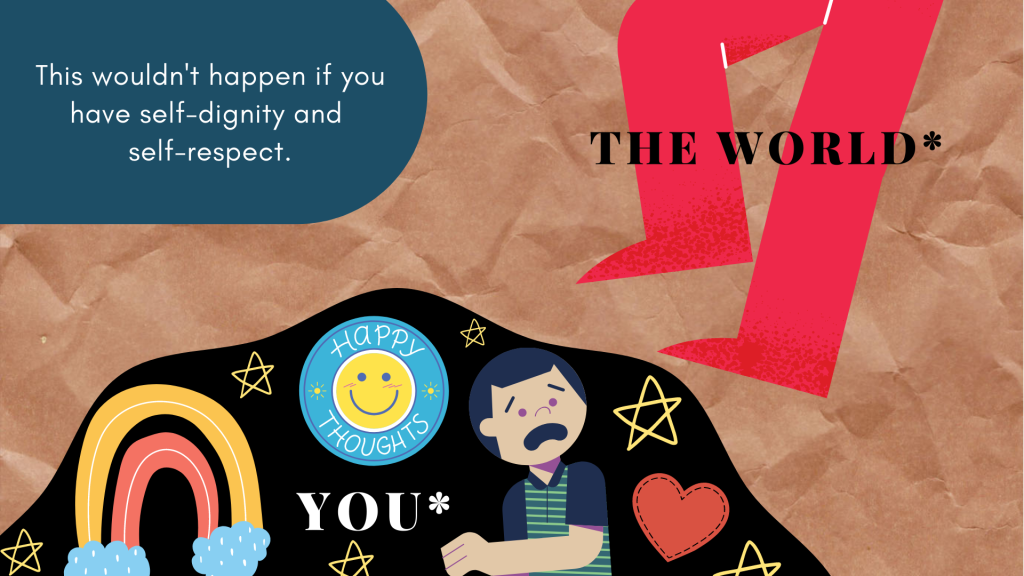
Self-Dignity
Every human being has worth and dignity and has the power to enjoy and avail basic human rights. The dignity of a person is one such right that we all should have the freedom to possess. However, having a sense of self-dignity comes from having self-respect and if you ‘feel’ like you are worthless and are not worthy of being respected, that’s when self-sabotage begins and the development of a positive self-image comes to an end.

Self-Esteem And Self-Worth
Self-esteem can be attributed to the self-worth of a person. As mentioned above, a healthy self-image and self-concept go hand in hand with having and developing positive self-esteem. And, this is one of the reasons that we should consciously and subconsciously try to create and establish a positive self-image.

Self-Confidence
With self-respect, self-dignity and good self-esteem come self-confidence. As you can see, all this is inter-connected! A part of being confident is believing in our strengths, capabilities, abilities, skills, and potential. If you observe people with positive self-confidence, you can see that they seldom get involved in something called ‘self-doubting’. That is what we are most prone to, in life. Actually, it is all our mindset. In order to build self-confidence, what do we primarily require? A positive self-concept! What leads us to success is a positive mindset and it is a no-brainer and striving to possess that is no easy task, but it will be worth it, in the end!

Self-Growth And Development
Now, what is the point when you have self-esteem and is self-confident, and just feel like that is all it takes to be successful in life? You see, that is not the right mindset. If you feel like you are in a good place in life and just sit there doing nothing to further improve yourself, others with high self-esteem will immediately run over you.
A person who wants to be self-actualized will continuously and consistently try to engage in self-growth and self/personality development activities, as living is learning and the learning process in life never ends, until our death, of course! The moment you think that your learning has ended is when you stunt your growth. Therefore, make it a big deal to involve in self-growth-related activities.

Self-Awareness, Self-Control And Self-Discipline
A positive self-image will encourage our minds to be more self-aware and in control of our thoughts and emotions. It will act as a guiding force by aiding us in developing a moral compass and enable us to say ‘yes’ or ‘no’ when the situation demands. It will help us in distinguishing between what is right and wrong to us. Real growth starts from self-awareness if you ask me! You can rarely make bad choices when you have self-respect and is self-aware.

Self-Actualization
We all know about Maslow’s ‘hierarchy of needs’ where he talks about a hierarchy of human needs with the help of a pyramid, as illustrated above. The ultimate level that we should aspire to reach is the level of self-actualization. And, all that is possible by having a solid, positive self-image.

Now, who wouldn’t want all that? Isn’t that what we should actively strive for? All of that is possible and easy to accomplish once you have a strong foundation and that is a healthy/positive self-image.
Since we have discussed various concepts related to our self and body image, let us take a look at the various ways in which we can embark on the journey of developing a positive self-image and self-concept.
Seven Ways To Develop A Positive Sense Of Self
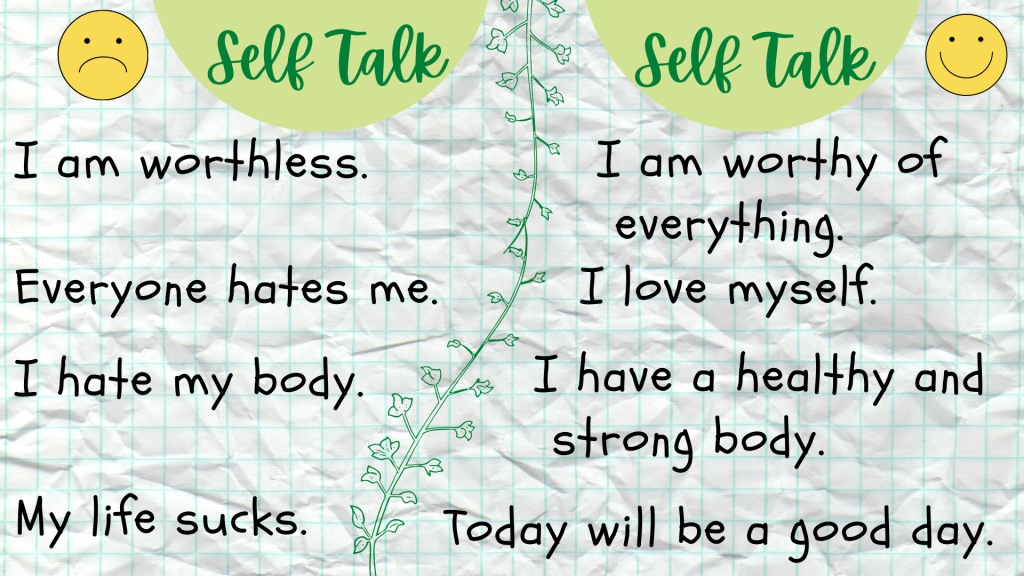
Engage In Positive Self-Talk
Self-talk is an activity that we indulge in from time to time, every single day. It’s time to take note of it and make sure that we try our best to maintain an optimistic outlook towards all the problems that we encounter on a day-to-day basis. Positive self-talk makes you more self-aware and self-confident.

Practice Gratitude Journaling To Explore Yourself
I’ve stressed the importance of journaling and gratitude journaling enough and more times in my articles and I will do that again! (Probably till the time you pick up a journal and start doing it for real). The point is, if you can’t engage in positive self-talk, at least you can spare some time by writing down your inner thoughts, feelings, ideas, and opinions. All of this immensely helps in developing a good self-image.

Do Some Soul-Searching
Spend time alone with your thoughts. Soul searching means evaluating how you are feeling and what is important to you. Re-evaluate your life, build new relationships, cultivate a passion, and participate in spiritual practice, etc. Do anything that you love with the ultimate aim to get to know your true motivations and purpose in life.

Read, Read, Read!
Read and gain more knowledge about the things that hinder you from developing a positive sense of self. There are so many amazing self-help books available, that help you understand and develop your self-image. You never know what works for you unless you give it a try!

Pause And Focus On Yourself
Take time from your busy life and focus on your inner feelings, thoughts, and emotions. It is because no one else is going to do that for you. Only you have the power to know yourself better and befriend your soul. Do it!

Be In Touch With Your Subconscious Mind
This is an important trait of a self-aware person. It takes time to reach that level of understanding your subconscious mind and analyzing your true motives but with time and dedication, you can get there.

Start Maintaining A Life-Diary
Even if you aren’t into writing, I suggest you keep a diary wherein you at least write down a summary of how your day went. It doesn’t matter even if you have been staying at home for a long time and have nothing ‘interesting to do’. Once you start writing, don’t stop. Write every day.
I have tonnes of journals in my cupboard and now that I take my old journals and read, I can definitely understand myself better and know what all progress I have made in my personality and life so far. I highly recommend it! The trick is to write every day though. You can even start a personal blog for that!

Maintain A Self-Discovery Journal
Embark on the journey to self-discovery with the aim to build and develop a positive sense of self as well as to get to know yourself deeply. Down below is the word file of the self-discovery prompts that I have made. Hope you find it useful!

Things To Remember
By building a healthy self-image, you can learn to be more assertive. You will value yourself, and won’t let others run over you or use you like a doormat.
The major reason why we should build and develop a positive self-concept and image is because we are human beings and we are unique. We have the unique ability to ponder on our ‘self’ as no other living being is gifted with something called ‘consciousness’. I am pretty sure that whoever is reading this isn’t a robot because they lack this ability and Artificial Intelligence is limited!
Furthermore, having a positive sense of self limits us from falling into an existential crisis from time to time!

So, take a look in the mirror above, pause, reflect. Find out who you are!
© That Pink Journal. All rights reserved
Kindly refrain from reblogging or linking my article or articles or blog content in your blog without my permission. I am strictly against content theft and not a fan of it as I spend a lot of time and effort in putting forward quality content. Just writing this down here explicitly because I see people doing that without understanding what copyrighted material means.

Quite a profound post.
Sometimes, it’s difficult to go with the flow.
Judging with a positive mindset is the value we need.
LikeLiked by 4 people
Thank you for your thought on this, Tanishq!
And, I totally agree with you. 🙂
LikeLiked by 4 people
Thank you for a very well researched and written post. It must have taken a good bit of time to get this together.
LikeLiked by 5 people
Haha, yeah! I do love the researching process though.
Have a great day. ❤
LikeLiked by 4 people
Informative post 😊🌹
LikeLiked by 2 people
Thank you! 🙂 ❤
LikeLiked by 2 people
Very interesting and insightful 👌👌
LikeLiked by 4 people
That means a lot, thank you! ❤
LikeLiked by 3 people
A very well researched informative post written in a profound way! Very interesting it was! ❤️👌
LikeLiked by 4 people
That means a lot to me. Thank you so much for the appreciation! ❤
LikeLiked by 3 people
My pleasure ❤️!
This piece was worth an appreciation!
LikeLiked by 2 people
That’s so sweet of you!<3 ❤
Take care and stay healthy~
LikeLiked by 2 people
Great research for a great result!
LikeLiked by 2 people
You are too sweet! Thank you so much! ❤
LikeLiked by 2 people
🙏💜🙏💜🙏
LikeLiked by 1 person
Soo informative, and the research wow. Keep up the good work
LikeLiked by 3 people
Your kind words of appreciation means a lot to me. ❤
Much love. ❤
LikeLiked by 2 people
You are welcome
LikeLiked by 2 people
Very helpful, thank you so much !
LikeLiked by 4 people
Thank you for your valuable feedback.
❤
LikeLiked by 1 person
Well-researched post with lovely and appropriate illustrations. Waiting for the next.
LikeLiked by 3 people
Thank you for the appreciation. It means a lot! Loved your blog as well! 😀
Have a beautiful day ahead. ❤ ❤
LikeLiked by 1 person
This is one of the best articles on the subject. Very well presented. Hats off
LikeLiked by 3 people
It means a lot! Thank you so much. ❤
LikeLiked by 2 people
Interesting article
LikeLiked by 3 people
^_^ ❤
LikeLiked by 2 people
Thanks for sharing this .
LikeLiked by 2 people
❤ 😀
LikeLike
So, I’m not gonna lie, you almost lost me a few times because of the length and my brain capacity. But this had brilliant information. I loved the quote by Charles Cooley. So interesting. Thanks
LikeLiked by 4 people
Haha, I understand. 😀 That’s totally normal. That’s why I make and put up illustrations in between! You can always bookmark my articles and read it part by part whenever you feel like (because our brains definitely do have a threshold!). xD
Also, thank you so much for your honest opinion. Much appreciated! ❤
Have a great day/night ahead~
LikeLiked by 1 person
What a very very profound post! I love all the wonderful illustrations you had in between. Had to take some time to process all this info. Can imagine how tedious it must have been to research, write and bring this post to completion, no matter how much you enjoy the process. If I may ask, which app do you use for creating illustrations? They are so colourful and give a good break from the text. 😛
LikeLiked by 5 people
Thank you, Sahana! ❤ I really appreciate you for taking the time to express your thoughts. ♡( ◡‿◡ )
And yeah, I do agree that it was a time-consuming process, and I had to stop somewhere cause this is a vast topic! (I get too carried away, hehe!).
As you said, the primary purpose of making and adding these illustrations is to break the mundanity. ^_^
The GD platform that I mostly use is Canva! ʕ•ᴥ•ʔ
LikeLiked by 3 people
This was really interesting! Enjoyed it heaps. Almost like reading a book but it was even better.
LikeLiked by 2 people
Very rarely it seems to do I reach self actualization in Maslow’s hierarchy of self needs but certainly I owe it to myself to give that a try.
LikeLiked by 1 person